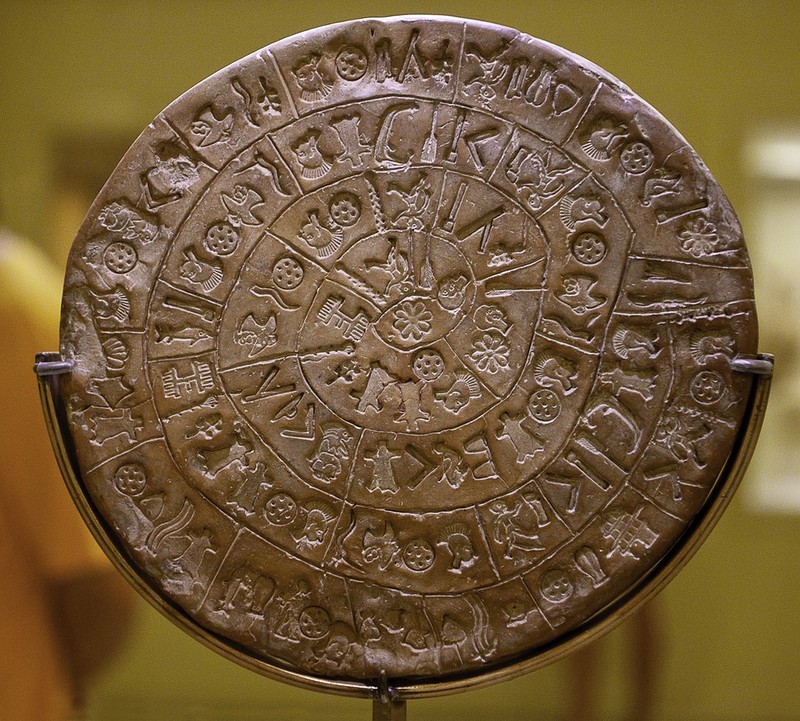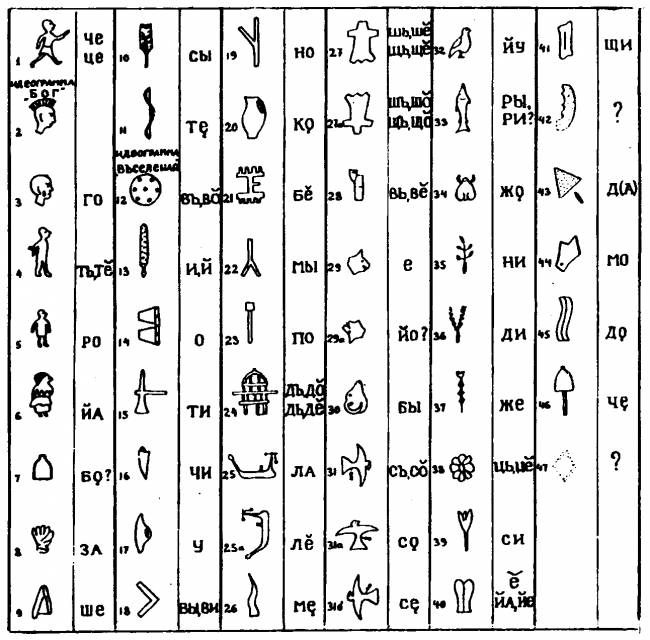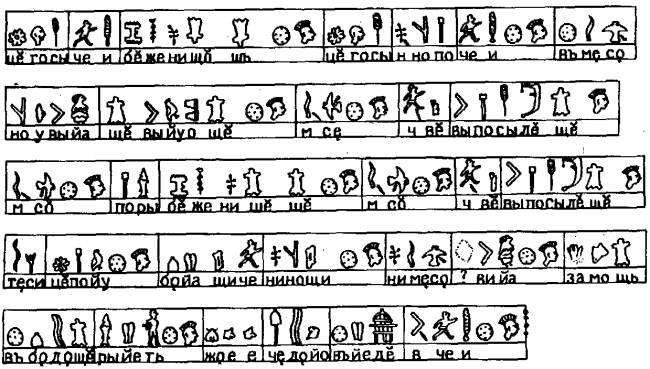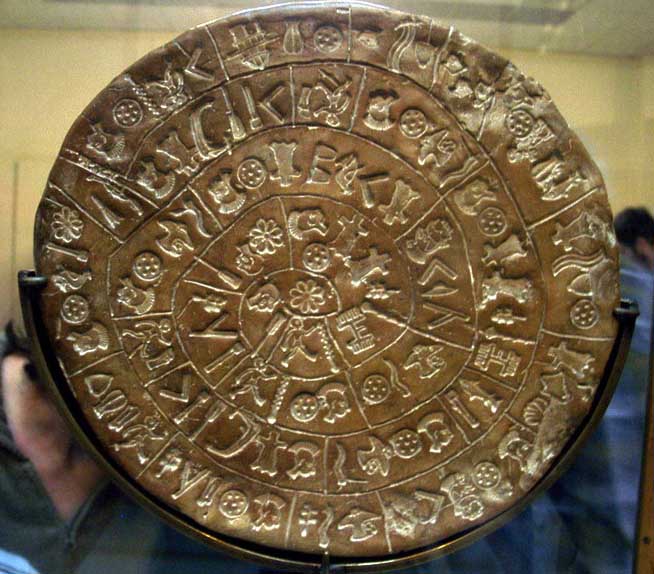DepthReading
Unsolved mystery of Phaistos disk
Many world riddles and mysteries are connected with world archeology. And not always these riddles lie on the surface and are as huge as the Egyptian pyramids. Sometimes they easily fit and, I’m in the hands of a man, but many centuries and millennia are hiding in the earth. While archaeologists do not extract them into the light of God.
The next working day on July 3, 1908, the Italian expedition, which was digging up the ruins of the royal palace in Festa, on the island of Crete, was drawing to a close, when an archaeologist L. Pernier, who was clearing one of the back rooms of the palace, discovered a small disk of well-burned clay.
The surface of the object taken from the ground on both sides was covered with unknown letters. The ribbon of calligraphically executed picture signs was twisted into two tight spirals. Inside the inscriptions on both sides were allocated groups of signs enclosed in rectangular cell fields. It was evident that the ancient calligrapher used a technique that anticipated printing. Each sign was found to be imprinted with a specially cut miniature print. The set of stamps was undoubtedly made in advance and was hardly intended for the reproduction of a single small text.
According to archaeological data, the Phaistos disk should be dated around 1600 BC. e. – the period of the formation of the Crito-Minoan civilization. For a long time there was an open question about the place of manufacture of the ceramic disc – whether it was made on the island of Crete itself or by someone brought here. But during the excavations in the thirties of the last century cave sanctuary in Arcohor (Central Crete) was found a cult copper ax with an engraved inscription on which there were signs from the Phaistos disk.
In addition, as shown by the study of other archaeological finds, the Cretan ceramics masters, long before the manufacture of the Phaistos disk, knew the technique of applying a clay object to the surface before burning it with images printed with specially made matrices.
The brevity of the Phaestos disk-in it 45 kinds of different signs, total 241 characters-does not allow making far-reaching conclusions on the basis of its statistical analysis. However, it is still possible to find out in principle what kind of writing system this was. The number of characters on the disc is too large for the alphabet, but at the same time too little for the hieroglyphic writing, that is, the verbal syllabic, where the signs are counted in the hundreds. Therefore, the writing of the Phaese disk scientists identified as syllabic.
Note that the first samples of such a so-called linear letter were discovered by the famous English archaeologist Arthur Evans in 1900 during excavations of another large Cretan city of Knossos. In total, Evans found there samples of three, apparently related to each other, Minoan letters. The first of them included signs that had, like ancient Egyptian hieroglyphs, a drawing character and depicted various specific objects. Evans called it Cretan hieroglyphics. Two other types of writing of the ancient Cretans with signs of generalized outlines that for the most part clearly lost direct resemblance to their iconic prototypes received the names of linear letter A and linear letter B.
Attempts to decipher the Cretan letters began with their discovery, but for a long time were unsuccessful. Before the Second World War, a young British explorer Michael Ventris (1922-1956), who was destined to solve this very complicated task, began to work on deciphering the linear letter B. The path to his success was largely built by the works of American scientists – Alice Kober and Emetta Bonette.
Success in Ventris came in 1952, when, using the results of the formal analysis of the inscriptions produced by Kober, he was able to develop much deeper his observations about the presence of grammatical endings in the studied language and was able to draw up a special grid that reflects their alternation. Now it remained to find out which of the ancient languages could fit into the grid it had received.
For many years, Ventris thought that the language of the tablets of the linear letter B should be Etruscan, because the language of the Etruscans, the ancient inhabitants of Italy, judging by many sources, is related to its origin with the Aegean world. In any case, he did not allow the thought that it could be Greek. In his time, following the theory of his compatriot Evans, Ventris even wrote: “The hypothesis that the Minoan language could turn out to be Greek, of course, is based on the sheer ignoring of historical probability.”



However, the Etruscan language did not grammatically fit the Ventris grid. And then the researcher decided, just in case, for the sake of experiment, to check how much the Greek had approached to it. The result was amazing: the Greek language came up just fine. The decipherment of the linear letter B made by Michael Ventris helped not only to read the ancient Greek texts of the second half of the second millennium BC. e., but also created the basis for a fruitful study of other monuments of writing of the Egeida of the pre-Greek period, including the writing of the Phaistos disk.
Thanks to the achievements of Ventris, it was really possible to read the overwhelming majority of the inscriptions made by linear letter A, many of which are the same as the signs of linear B. With the writing of the Phaistos disk everything is much more complicated. Successes can be called only partial. And over the decoding of it, not only professional linguists are beating, but also numerous amateurs and enthusiasts.
The closest to all to the disclosure of the mystery of the enigmatic inscription on the disk came Russian historian and linguist A. A. Molchanov. At one time, the journal Nauka i Zhizn already told about his works (see No. 2, 1983), but in the most complete form they are set forth in his book “The Ambassadors of the Lost Civilizations (Letters of the Ancient Aegeida)” (M., Science “, 1992).
So, the linguist A. Molchanov, with the care and thoroughness of a true professional, conducted his analysis of the text and came to the conclusion that the so-called sign 02 – a human head with a cock’s comb – conveys a mixed image of a man and a rooster, an animal that was long revered on the island of Crete as an attribute the supreme solar deity.
According to the ancient mythological and historical tradition, the ancient Cretan lords, the descendants of King Minos, built their race to the sun god and the cock served as their patrimonial emblem. The fact that the prototype for the sign of 02 served as a sacred dynastic symbol allowed Molchanov to consider him a determinative, in other words, a determinant of the names of mino-ka rulers. In the text this sign is accompanied by 19 words. Consequently, it lists the names of 19 Minoan rulers.
Journalist Vladimir Mikhailov, after years of working on decrypting the disc, found, as he believes, the key to the mystery. In his opinion, the disk reproduced prayers, which the Cretan grain growers sang while processing fields and harvesting. On the front side of the disc is supposedly a prayer of “revival of the bread spirit.”
However, the most original interpretation of the text of the Phaistos disk was offered by the notorious Gennady Grinevich, a geologist by profession. Considering the inscriptions of the Phaistos disk similar to the Slavic writing such as “features and cuts,” it deciphers the front side of the disc:
“You can not find past sorrow, but today’s sorrows are bitter. In a new place you will feel them. Together. What else did God send us? A place in the world of God. Fracas of the past do not count. The place that God has wished you, circle in close rows. Protect it day and night. No place – will. Even her children are still alive, knowing who they are in this world. ” The text on the reverse side: “We will live again, there will be worship of God, everything will be in the past – we will forget who we are. There is a child – there is a bond – we forget who we are. What count, God. Ressiyaniya charms the eyes. You can not get anywhere from it, you can not cure it. Not once it will be, we will hear: whose will you, trotters, what honors for you, curls helmets, talk about you? Not yet, we will be her. ”
When decoding, A. A. Molchanov used combinatorial analysis. First of all, he revealed on the disk the personal names of the rulers, and then – the toponyms, that is, the names of the Cretan cities. Having successfully solved this problem, the researcher was able to construct a so-called artificial bilingual, that is, an artificially created bilingual inscription, the reading of a part of words is known from previously deciphered monuments. Having created this bilingual, it was possible to work with it in the same vein in which François Champollion worked a century and a half ago with a really extended Greek-Egyptian bilingual – Rosetta stone (which allowed him to read the Egyptian hieroglyphics for the first time). AA Molchanov’s method was highly appreciated by many outstanding scientists – academician AV Artsikhovsky, ID Amusin, N. Ya. Merpert, LA Gindin, OS Shirokov and others. She allowed to read most of the signs of the Phaistos disk and not only in general terms, but also with a certain detail to understand the content of the inscription. According to Molchanov, the disk contains a message about the dedication of this subject to the sanctuary of King Knossos (the main center of ancient Crete) and the rulers of other Cretan cities subordinate to him. Obviously, the disk did not exist in the singular: each of the participants in the initiation probably received a personal copy, made by replication. One such specimen, owned by the ruler of Fest, came to us. It is not excluded in the future to find in Crete other copies of the disk or their fragments.
In accordance with the hypothesis of Grinevich, some tribe of lynx-whose was forced to leave their homeland in Tripoli, in present-day Ukraine, and move to the island of Crete, where it created the original culture of the island. In Soviet times, Grinevich repeatedly applied his hypothesis to the Institute of Slavic Studies and Balkan Studies, the Institute of the Russian Language of the USSR Academy of Sciences and the Moscow State University, but received negative answers everywhere.
Who did not try to unravel the contents of the mysterious inscription: historians, linguists, and just lovers of the antiquity of the whole world! What they did not try to read on the Phaistos disk! That is a hymn in honor of the supreme deity, then “guide” to the holy places of Crete, then a brief historical chronicle … Some researchers compared the signs on the disk with the signs of other famous writing systems. Others tried to guess the meaning of signs based on their external appearance. Still others have seen the key to the clue, counting how often there are signs in the inscription. To no avail.
One of the latest hypotheses was published in the journal Science and Life (see No. 1, 1998). Its author – the German philologist D. Olenrot – suggested that the inscription was made not by signs of real writing, but by a certain cipher, behind which the letters of the classical Greek alphabet lie. Proceeding from this premise, Olenrot read on the one side of the disk the magic formula of the rite in honor of the Greek goddess Demeter, and on the other – information about the temple of Zeus in the city of Tiryns, one of the most important centers of the so-called Mycenaean civilization that flourished in the 2nd millennium BC in the south The Balkan Peninsula.
Reading, and the approach to the decipherment of D. Olenrot, cause several fundamental objections.
Undoubtedly, everyone is free to act in his own way, one can begin deciphering from a “clean sheet”. But, probably, it would be more correct if the author, when starting work on the inscription, , relied on already firmly established facts. For example, today most researchers consider a system of writing applied on a disk, not alphabetic, but syllabic. In other words, each sign of this writing corresponds not to a single sound of speech (as in Greek or any other alphabet), but to a whole syllable. It is estimated that in the syllabic writing of the Phaistos disk there were 60-70 characters, 45 of which are found on the disk itself. Everyone agrees that 60-70 characters are too much for an alphabetic letter (the modern Russian alphabet has 33 letters, the alphabets of European countries – even less, the classical Greek alphabet was 27, then 24 letters).
However, D. Olenrot tries to connect these two different systems of writing. Some signs of the Phaistos disk, in his opinion, express not single sounds, but diphthongs (that is, combinations of vowels, for example – ai, hey, eu). From my point of view, this does not add credibility to his hypothesis: the diphthongs in the Greek language have always been written separately. And the next. According to the decipherment proposed by Olenroth, one and the same Greek letter for some reason can be expressed on the disc in different signs. Thus, the letter “sigma” (c) corresponds to four unlike signs, the letter “iota” (i) – three, the letter “omicron” (o) – two … What is the use of this kind of strange cipher? Yes, they simply could not use it.
As already mentioned, the Phaistos disk appeared in 1600 before the new era, and the material available today at the disposal of scientists proves that the Greek alphabet did not appear until the 9th century BC. He formed the pattern of the Phoenician letter, as indicated by the similarity in the writing of letters, and even in their name. But the very Phoenician letter (incidentally, which had signs only for consonant sounds) arose nevertheless later than the Phaistos disk. What gave the scientist a reason to push the origin of the Greek alphabet in a more ancient time?
And, finally, the third objection. Olenrot believes that the birthplace of the Phaistos disk is not Crete, where it was found, and the mainland Greece. This follows from the Greek language, on which an inscription was written (it was not yet spoken in Crete at that time in Greek), and from its content, which narrates about the Greek, and not about the Cretan temples.
However, much says that the Phaistos disk was created in Crete. Evidence of this is the island origin of clay, from which the disk is made, and the local, Cretan realities became the prototypes of all the signs of the disk. Particularly important is the copper ax, found by archaeologists in one of the Cretan caves, referring to the same time as the disk. It retained a distinctive inscription, interspersed with the signs of the letter of the Phaistos disk and the so-called linear letter A, widely distributed in Crete at that time. (With the help of the letter A, the Cretan, that is, the Minoan, non-Indo-European language was transmitted.) And therefore, there is no doubt that these two systems of writing functioned on the island at the same time, were interchangeable. Apparently, they were used in different spheres of life: a linear letter A served for business and economic documents, and a letter from the Phaistos disk for for religious, sacral texts. This also confirms: the language of the Phaistos disk is not Greek, but Minoan.
Offering his decoding, Olenrot reads the inscription on the disk from the center to the edge and gets the meaning he needs. However, some experts who studied the technique of applying signs, believe that this process was moving from edge to center. It would seem, then, and read the inscription follows exactly this way.
So, despite some successes, the mystery of writing the Phaistos disk remains almost as insoluble as a century ago.
Category: English
DepthReading
Key words:

